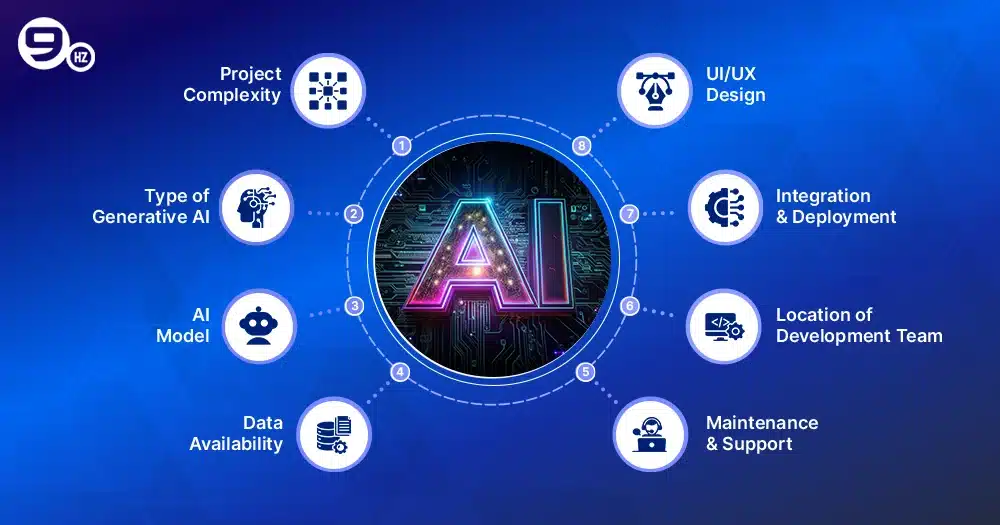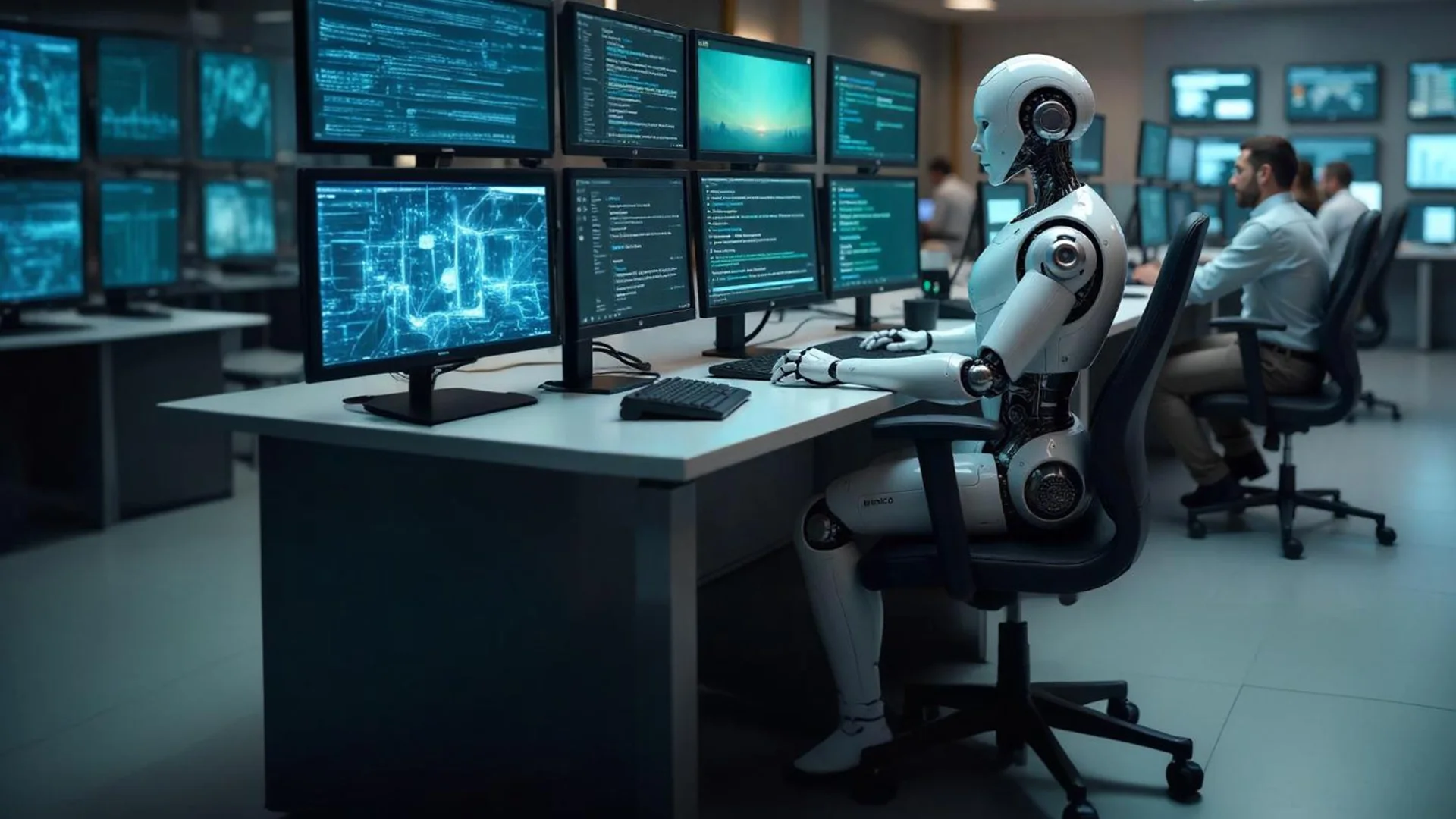The generative AI development costhas always been a curious concern among businesses due to its potential to automate tasks, bring efficiency, and boost accuracy. According to Grand View Research, the global generative AI market was valued at $16.87 billion in 2024, which is expected to show a significant CAGR of 37.6% to achieve the valuation of $109.3 billion by the end of 2030. The statistics well portray the growth of this amazing technology and how it can transform businesses to lead a sustainable yet fast growth.
If you are also a business owner looking to impart generative AI capabilities into your operations for better accuracy and efficiency, it is very important for you to have a clear idea about the cost of generative AI. The understanding will not only help you to carry out the development planning but will also make sure that you partner with a generative AI development company that can build a result-driven solution without burdening your pocket.
The cost of developing a generative AI application generally ranges between $50,000 to $400,000. However, you must be mindful of the fact that the cost of generative AI development is entirely variable as it depends on a range of factors. For example, choosing the features wisely can help you control your cost.
To make the understanding more clear, we have talked in this blog all about generative AI costs, influencing factors, what you should be cautious about during the development, and how you can control the cost.
Generative AI Development Cost: An Overview
As interpreted in the earlier section, there is a range of factors that affect the generative AI pricing. For example, if you are looking to build a generative AI solution merely for replying to the queries of customers, it will cost way less than as compared to building a full-fledged generative AI system like ChatGPT that can perform several tasks simultaneously.
Here are the estimated costs of generative AI, defined from multiple POVs and criteria.
1. Basis of Complexity
There are multiple complexity levels of a generative AI application. For example, some solutions are designed only to produce texts according to the command provided by the users, while the more advanced generative AI systems are capable of supporting multiple formats like voice, images, and texts as input and are even more capable of producing input in these same formats. The basic generative AI Tools are cost-efficient as compared to building advanced and complex generative AI solutions.
| Complexity Level | Core Competencies | Estimated Cost (USD) |
|---|---|---|
| Basic | An elementary generative AI system with predefined data inputs and text or image generative capabilities. | $30,000- $50,000 |
| Moderate | A custom AI model that is trained with larger datasets to generate images and perform like a chatbot at times. | $60,000- $100,000 |
| Advanced | A complex AI solution with deep learning and fine-tuning capabilities that can handle multiple tasks simultaneously. | $100,000- $500,000 |
92% of Fortune 500 companies have adopted generative AI.
2. Types of Generative AI Models
There are different types of generative AI models that a business owner can choose according to their particular requirements and target audience. For example, if you are only looking for an AI-supported chatbot, a text generation tool is most sufficient and cost-efficient. On the other hand, an entertainment industry leader would require an advanced generative AI application that can work on different media formats like texts, images, videos, audio, etc. The increasing functionality of the solution also increases the generative AI development cost.
| Types of AI Models | Description | Estimated Cost (USD) |
|---|---|---|
| Text-to-Text Model | Take text commands to generate texts for translation and summarization | $40,000 – $100,000 |
| Text-to-Image Model | Accepts text commands to generate relevant images in multiple formats, like sketch, ghibli, etc. | $60,000 – $120,000 |
| Text-to-Video Model | A generative AI model capable of generating videos from the provided texts | $60,000 – $150,000 |
| Text-to-Speech Model | AI narrators and voice synthesis features | $60,000 – $120,000 |
| Speech-to-Text Model | Advanced solutions that perform audio transcription and accept voice commands | $70,000 – $150,000 |
| Code Generation Model | Generates accurate codes according to the user prompt | $100,000 – $500,000 |
| 3D Model Generation AI | Creates 3D assets for AR/VR, metaverse solutions, and gaming apps | $200,000 – $600,000 |
| Data-to-Text Model | Accepts the data files to structure complex data and provide actionable insights and narratives | $80,000 – $300,000 |
3. AI Development Phases and Cost Breakdown
The generative AI development process consists of several phases, like ideation, designing, development, model training, and much more. Each of these phases requires certain resources and costs that help to operate the infrastructure. The customization in these project phases also leads to a lot of alterations in generative AI costs. At the same time, every step consumes a certain percentage of the overall development cost. Have a look at the table below for a better understanding.
| Project Phase | Tasks | Estimated Share in Total Cost | Cost Range (USD) |
|---|---|---|---|
| Planning and Ideation | Feasibility study, requirement analysis, feature prioritization, and strategy formulation | 5% – 10% | $5,000 – $20,000 |
| Data Collection and Fine-Tuning | Locating data sources, collecting data, cleaning and filtering quality data, data labelling, and augmentation | 15% – 25% | $10,000 – $50,000 |
| Model Training and Development | Algorithm selection, model training, fine-tuning | 30% – 40% | $30,000 – $100,000 |
| Quality Analysis and Validation | Bias detection, performance testing, speed testing, bug removal | 10% – 15% | $15,000 – $50,000 |
| Deployment & Integration | Cloud deployment, AI development, legacy system integration | 10% – 15% | $15,000 – $40,000 |
| Post-Deployment Maintenance & Support | Periodic updates, scaling support, and retraining | 5% – 10% | $10,000 – $100,000 |
4. TOP generative AI tools cost to build
Having an idea about the cost of building tools resembling popular generative AI examples like ChatGPT, Dall-E, Midjourney, etc., can be a good approach to predict the generative AI development costs for similar tools. While all these tools are supported by powerful large language models, many with their dedicated infrastructure, you can build a replica of such apps by opting for some ready-to-use platforms and third-party integrations. Here are the estimated costs of some of the replicas of some popular generative examples.
| Popular Tools | Estimated Costs |
|---|---|
| ChatGPT | $500,000- $2,000,000+ |
| Dall-E | $400,000- $1,500,000+ |
| Jasper AI | $200,000- $1,000,000+ |
| MidJourney | $400,000- $1,500,000+ |
| GitHub Copilot | $200,000- $1,000,000+ |
8 Key Factors That Influence Generative AI Development Costs
There are a number of factors that affect the generative AI costs. Once you have an understanding of these factors, it becomes easier to estimate the cost as well as make a wise decision towards cost saving.
1. Project Complexity
As defined earlier, the complexity of generative AI applications varies according to the specific use of the software. However, you must understand that the generative AI pricing is highly affected by the complexity level of the project. If the solution is highly complex to develop that requiring a vast team and an extended timeline, the cost will automatically be higher. On the other hand, building a basic generative AI application is comparatively easier.
2. Type of Generative AI
Different types of generative AI models generate texts, images, videos, speech, code, and even 3D replicas. However, each of these generative AI models requires different expertise, time, and technical resources. So, the type of generative AI solution that you choose has a significant impact on the overall development cost.
3. AI Model
Working on an advanced or custom-trained model with a high-end algorithm is generally expensive, as it helps to build ultra-capable generative AI software. However, if a business requires simple chat support from the AI solution that doesn’t need any exclusive data, it can lower the generative AI development cost.
4. Data Availability
The generative AI working is entirely dependent on the quality and quantity of the data. So, if the solution development requires high-end data in large amounts while ensuring the quality, you might have to rely on many data sources, most of which provide data at a price. Similarly, if a business is looking for a solution that has to work solely on the internal data of the organization and doesn’t need to outsource the data, it can be developed comparatively cheaper.
5. UI/UX Design
Every generative AI system is developed with a basic user interface that allows the stakeholders to access the features and navigate through different phases. However, many businesses prefer to customize the user interface by adding interactive components and 3D elements that make the interface look more attractive and easy to use. However, you must understand that these types of customization often attract additional costs of developing a generative AI application.
6. Integration and Deployment
There are two types of integrations. The first one is third-party integration, in which the development team integrates multiple third-party platforms and services into the solutions that help to bring certain functionalities. The other is the integration of a generative AI model into the existing legacy system of the business. Both of these integration requires the technical resources and human expertise, which influence the generative AI costs.
7. Location of Development Team
This is one of the biggest factors that affect the cost of developing a generative AI application. The reason behind the statement is that partnering with an AI development company in countries like the USA, the UK, Australia, and Europe costs more than twice as compared as hiring the development team from a country like India with the same expertise.
8. Maintenance and Support
A generative AI solution requires consistent technical support that helps to identify the bugs and remove them. At the same time, maintenance services also ensure the timely updates and feature optimization of the solution. However, you will have to pay a monthly fee to the AI development company to opt for maintenance and support services that will influence your generative AI development costs.
Cost-Saving Strategies for Generative AI Development
The cost of developing a generative AI application is associated with multiple components, and compromising with the features, capabilities, and competencies of the software to save costs is not a good idea. However, there are many practices that you can ensure to bring the generative AI pricing down, without impacting the overall quality.
1. Use Pre-trained AI Models
Building the generative AI solution from scratch is mostly expensive and time-consuming. Thus, it is a good approach to rely on the pre-trained AI models like OpenAI’s GPT (for text generation), Stable Diffusion or Dall-E (for image generation), and Google’s Bard or Meta’s Llama (for conversational capability). These pre-trained AI models can be customized according to specific application requirements, thus reducing the cost as well as the timeline.
2. Utilize Open-Source Frameworks
Using the paid platforms and frameworks significantly increases the generative AI costs. So, you can choose an open-source framework that helps you to leverage the powerful tools without paying any licensing costs. There are a number of options for open-source frameworks. For example, TensorFlow or PyTorch can be used for deep learning projects, Hugging Face is ideal for NLP applications, and Fast.ai is considered for simplified AI development.
3. Optimize Infrastructure and Cloud Costs
Choosing the cloud-based platforms will eliminate your need to purchase high-cost on-premise hardware. There are a number of cloud providers like Google Cloud, AWS, and Azure AI services where you can select the pay-as-you-go option to scale the resources efficiently. Moreover, you can opt for AI accelerators like NVidia GPUs or Google’s TPUs to enhance the performance while controlling costs.
4. Use AI-as-a-Service Platforms
Many companies offer AI-as-a-Service (AIaaS) that helps businesses access AI tools without making huge investments. Many popular platforms are Google Vertex AI, Amazon Bedrock, and IBM Watson AI, which offer pre-built AI functionalities to eliminate the need for in-house development of functionalities.
5. Choose the Right Hiring Model
Choosing the incorrect hiring model without analyzing your project requirements might cause you a big financial loss. For example, if you hire a dedicated team for a short-term project, it will increase the generative AI development costs. So, choose a hiring model like project outsourcing, where you partner with a good AI development company to hand over all the project responsibility to experienced hands.
6. Keep the Vision Well-Defined
A well-defined project vision and goals will help you navigate the right development path while eliminating the chances of unnecessary feedback and rework. However, if you don’t have project objectives defined, there might the chances multiple re-dos that will increase the project timeline, waste resources, and thus ultimately increase the generative AI development cost.
Things to Consider When Implementing Gen AI in Business
Generative AI development cost is undoubtedly a big investment, and thus, it is important for any business to have thorough planning for the project to leverage the best outcomes. Considering some practices and factors can entirely turn the tables while offering more than expected benefits during and after the development.
1. Ensure to Create a Roadmap
If you plan to keep the project on the right track, the first thing that you need is a roadmap. No matter which AI development company you partner with, the ideal process of development is almost the same. So, make sure that you have a personalized roadmap consisting of the most important tasks like brainstorming, challenges identification, designing, development, training, deployment, and maintenance that ensure that you are never going off track and navigate continuously towards your goal.
2. Analyze Business Needs to Decide Features
Having fewer features might make your generative AI model useless in a short time. Similarly, having too many features will lead to a higher cost of generative AI development. So, you should always analyze your business to identify the current challenges and project objectives. It will help you to select the set of features that are essentially required by the stakeholders and will play a core role in mitigating the real-time business challenges.
3. Set a Realistic Budget
Getting too strict with a budget might make you compromise on quality software or an experienced development partner. Similarly, being too careless about the budget is also not a good idea, as it will lead to the wastage of financial resources. So, ensure to set a realistic budget by analyzing the factors and conveying your generative AI application development partner about the same, so that there are no chances of conflicts.
4. Check the Prototype
Before the final development, don’t forget to ask for a prototype from the development company. It is simply the rough structure of the generative AI solution that will give you a clear idea about the design, theme, features, navigation, functionalities, and everything. You can analyze this prototype and provide feedback. Implementing changes at this step is significantly more cost-efficient as compared to making changes at the later stages.
5. High Quality Data
No matter what, you should never compromise the quality and quantity of data during the generative AI development. Any bias or incorrect data will lead the solution to generate incorrect results, which will directly impact the reliability of stakeholders in the solution.
6. Employee Training
You can only enjoy the expected ROI of the generative AI system when your employees or team members know how to explore the utmost potential of the solution. So, connect with your development team and ask them to organize a training session where they can train the business employees to use different features, their benefits, and enhance the accuracy with efficiency.
7. Ensure Data Privacy
Make sure that the generative AI solutions that you want to build and integrate into your existing system align with the data privacy guidelines and security protocols. It will help to eliminate or at least reduce the chances of data breaches. At the same time, data privacy guideline also ensures that any crucial information of the business used to train the AI model is only accessible to the concerned authorities and no third party.
How can The NineHertz help you with generative AI development?
The very first requirement to leverage any benefit of a generative AI solution is partnering with the right development company. Whether it is making the project more cost-efficient or integrating the innovative features that bring a competitive advantage, an experienced generative AI development company can help you everywhere.
The NineHertz is a leading AI company with an experience of over 15+ years. We have a team of 250+ tech enthusiasts, keen to explore the new technological benefits and implement them for the client’s betterment. Here are some of our core competencies that make us stand out from the plethora of other AI companies in the market.
1. Free Consultation
We believe in a result-driven approach and consider it important for our clients to have a complete understanding of the project very beginning. So, we offer a free consultation session to any business looking to implement a generative AI solution in their operations. Our consultation session focuses on identifying business gaps, analyzing ultimate project goals, and thus curating the personalized strategy. We also navigate clients towards the estimated generative AI development cost and timeline according to their requirements.
2. Cost Efficient
Our years of experience in the AI development landscape allow us to implement best practices that help control the generative AI pricing. We make sure that any functionalities or the overall capabilities of the AI solution remain unaffected in the process of making the project more cost-efficient.
3. NDA
We sign a non-disclosure agreement with our clients and stakeholders. It makes sure that any information related to the client, business, or the project is not shared with any third party without their mutual consent. At the same time, the agreement also limits access to confidential information to the concerned authorities only.
4. Exclusive Domain and Industry Expertise
Each industry carries unique challenges, and thus, the use cases of generative AI systems also differ accordingly. Similarly, there are different types of generative AI solutions with their defined capabilities and purposes. We have specialized domain and industrial experts who help the development team to better understand the industry challenges and thus choose the ideal AI model that can bridge the gap and offer sustainable growth.
5. Maintenance and Support
Our team offers the best maintenance and support services after the project deployment. We offer 24*7 support where the clients can connect with our experts for any query, feedback, or implementation. Our post-deployment support ensures the periodic updates of the solution, adding or eliminating the features according to changing needs, and fixing the bugs as soon as identified by the user.
Conclusion
Generative AI development cost ranges anywhere between $40,000- $400,000. However, the exact cost is only determined by analyzing the range of factors like project objectives, complexities, data availability, third-party integration, development timeline, location of developers, and much more. However, partnering with the right AI development company can significantly help in controlling the cost without affecting quality.
If you are also a business looking to implement generative AI in your legacy system, we invite you to our free consultation session. You can reach out to us by filling out this form or connecting with us via our email [email protected].
FAQs
What is the average cost of building a generative AI model?
The average cost of building a generative AI model is $40,000- $400,000. However, several factors influence the exact costs. The core factors are business requirements, challenges, project complexity, developers’ location, project timeline, hiring model, customization, data availability, existing technology infrastructure, etc.
What factors make AI projects more expensive?
The factors like adding interactive features, integrating additional technologies like computer vision, customizing the user interface, adding third-party services, unnecessary rework due to the absence of a clear goal, etc., make the AI projects more expensive.
Can small businesses afford generative AI solutions?
Yes, small businesses can afford generative AI solutions. Small businesses often have limited stakeholders who will access the AI solution, and thus, the project complexity reduces, ultimately reducing the generative AI development costs.
Are there budget-friendly tools or platforms?
Yes, several budget-friendly and even free tools or platforms help to make generative AI development cost-effective. For example, you can use open-source frameworks, pre-trained AI models, leverage AIaaS (AI-as-a-Service), and optimize the infrastructure costs by relying on cloud architecture.
Great Together!











